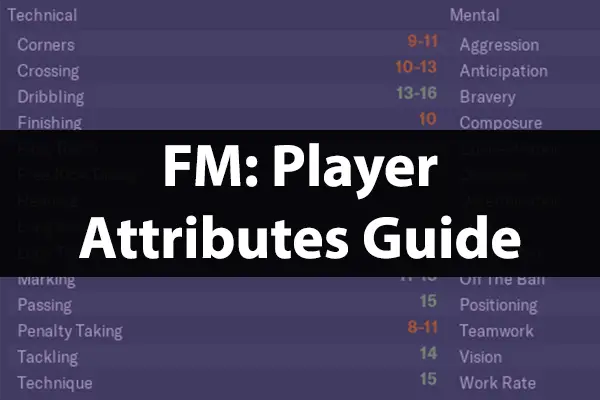The attributes of a football player are key to how they can perform on the pitch. Getting an understanding of the attributes can help you to build up a picture of the type of player you’re looking at, as well as their quality in comparison with the rest of their team.
Attributes are divided into three categories for outfield players: technical, mental and physical. In this guide, we’ll define what each attribute is and how the match engine perceives that particular stat.
Player’s attributes are rated from 1-20 – learn more about understanding player attribute ratings. With the majority of attributes, you should aim to develop players to reach as nearest to 20 as possible, however, some stats go against this rule.
There are also some hidden attributes. We can’t see what players are rated for these attributes so we’ll discuss how to figure out a rough idea of the ratings the player has for those.
Contents
Technical
Technical stats are focused on a player’s skill to manipulate the ball. Each of these attributes is mainly focused on how accurate a player is when performing an action with the football.
Corners
FM’s definition: The player’s ability to accurately take a corner.
A player with a high corners attribute will be able to take a pin-point corner more often, delivering the ball into the intended space or to a specific target. Ensure your best corner takes are assigned in the Set Piece setup of your tactics.
Crossing
FM’s definition: The ability to cross the ball accurately from wide areas.
Similar to corners, the crossing attribute is all about precision. If you’re looking for beautifully crafted crosses, whipped or floated, encourage your best ball crossers to be delivering them into the box.
Dribbling
FM’s definition: The ability to run with the ball and manipulate it under close control.
Players with high dribbling will keep the ball close to their feet, helping to navigate around defenders who may lunge in for a tackle. Footballers with strong dribbling may be effective running at goal with the ball, or perhaps when sprinting down the wing or cutting inside to challenge a defender.
Finishing
FM’s definition: The ability to put the ball in the back of the net when presented with a chance.
This stat reflects whether a player has the accuracy to score a goal when the opportunity arises. Ideally, a striker will have both high finishing as well as high composure, if they fold under pressure easily, a high finishing stat alone may not produce goals consistently. It’s worth noting that the finishing stat is believed to be how well the player can put the ball away when the player is in the penalty area – this differs from the long shot stat which is focused on shots from outside of the penalty area.
First Touch
FM’s definition: The ability to control the ball immediately as it is passed to feet.
As well as when receiving a pass, the first touch attribute is important for when receiving the ball from along the ground or from in the air. Often, a player’s first touch can allow them to quickly prepare for their next action should they make a brilliant first touch, meaning a striker can quickly get a shot on goal rather than potentially letting the ball bounce off of their boot into the opposition’s possession.
Whether your team is focused on quick short passing or more direct long balls, a great first touch can provide significant advantages going forward, as well as a solid defence that doesn’t make mistakes by easily giving the ball away.
Free Kick Taking
FM’s definition: The ability to strike a dead ball, either when having a shot or putting the ball into dangerous areas from deep or out wide.
The key thing to realise here is that the crossing attribute doesn’t have an effect on free-kick taking. Similar to the corners attribute, it is about the accuracy, either when the ball is being shot at goal, or when it’s being delivered into a dangerous area. If your team has no great free-kick takers, consider advising your team to play the ball short from a free-kick to make the most of the opportunity.
Heading
FM’s definition: The ability to head the ball.
Unfortunately, Football Manager’s definition of the heading attribute isn’t very useful to us, although it’s pretty obvious. A footballer with great heading will be able to head the ball more with more control, leading to a more dangerous shot or a more precise pass.
Think about your strikers and centre backs when looking at this attribute. Are they good at heading the ball? Remember, heading should be considered alongside jumping reach. If you’re looking for a centre back or striker that’s good in the air, make sure that they can get off the ground to reach the ball.
Long Shots
FM’s definition: The player’s prowess when shooting from outside the penalty area.
Similar to finishing, but from outside the box. A player with a super long shot can hit the target more often from distance, it doesn’t mean they’ll be a fanatic finisher in the box though. Coupled up with the player trait shoots with power, footballers high in the long shot attribute can be deadly if they find the room to unleash a rocket.
Midfielders who sit on the edge of the box are perfect examples of players who can cause damage when having a special talent for long shots.
Long Throws
FM’s definition: The ability to throw the ball long, often in attacking situations.
This stat purely relates to the distance of how far the ball can be thrown. If you’re looking to reach a target man who’s standing in a dangerous position, having a teammate to throw the ball long can be particularly critical for your opposition. They may also be able to launch the ball into space, providing your team with a brilliant opportunity to counter-attack.
Marking
FM’s definition: The ability to stick close to his direct opposition in defensive situations.
Being close to an opponent allows a player to quickly intercept them once they’ve received the ball, or by making their availability to receive a pass limited. This attribute defines how well a player can stay with the man they’re marking and how effective they are at preventing them from receiving the ball easily.
Passing
FM’s definition: The ability to successfully find a team-mate with the ball.
We all know what a pass it. A player with good passing ability is more accurate when creating a pass to their intended target.
Penalty Taking
FM’s definition: The ability from the penalty spot.
Being close to an opponent allows a player to quickly intercept them once they’ve received the ball, or by making their availability to receive a pass limited. This attribute defines how well a player can stay with the man they’re marking and how effective they are at preventing them from receiving the ball easily.
Tackling
FM’s definition: The ability to win the ball cleanly without conceding fouls in such situations.
Being close to an opponent allows a player to quickly intercept them once they’ve received the ball, or by making their availability to receive a pass limited. This attribute defines how well a player can stay with the man they’re marking and how effective they are at preventing them from receiving the ball easily.
Technique
FM’s definition: Reflects the aesthetic quality of a player’s technical game; how refined they are with the ball at their feet. Technique is important in being able to pull off a tricky pass or cross-field ball.
The technique attribute combines well with lots of other technical attributes mentioned above. A player who has this in abundance will play slicker passes, have more exquisite finishes, more confident dribbling and in general, perform better in complex situations using a variety of technique – the way in which something is performed. This isn’t to be confused with flair which is focused on the fancy footwork of a player.
Mental
Mental stats are all about what the player is thinking during a match and how they perceive and react to specific situations.
Aggression
FM’s definition: Doesn’t necessarily reflect a player’s dirtiness, but their willingness to get stuck in, perhaps at the expense of giving away more fouls.
You have to take Football Manager’s definition word for word. However, if a player is more likely to be putting in aggressive challenges, they’re more likely to make a mistake and pick up cards. It’s also sensible to think about your tactics if you have highly aggressive players. If you’re asking your team to get stuck in on top of high aggressive stats, they’re much, much more likely going to be getting a booking from the referee. To counteract this, ensure that players who are more likely to put in a tackle have good tackling, decision making and anticipation to improve their chances of a successful challenge.
Although it may be difficult, avoid associating this stat with how dirty a player is, this is explained more in the hidden attributes section below.
Anticipation
FM’s definition: Ability to predict and react to events going on around them.
Players who can predict the future are usually one or two steps ahead of the game. This attribute is useful for footballers with roles that look to intercept or break up the opposition’s play, as well as helping with creating chances for team-mates and finding the right moment to get into a better position to take advantage of what’s about to happen.
Bravery
FM’s definition: How committed a player is, often putting themselves into risky situations which may cause injury.
Ever seen professional players wimp out of a 50/50 or aerial battle. This is more likely to occur with smaller players who are a little more fragile. Bravery defines whether a player is likely to get physical and risk their fitness to win the ball back. It differs from composure as this is about being calm on the ball, whereas bravery is more about winning the ball back.
Composure
FM’s definition: The player’s steadiness of mind and ability to make intelligent decisions with or without the ball.
Strikers need composure to make tidy finishes under pressure, either from a defender or the occasion. Composure is particularly important when shooting from the penalty spot or making a dangerous tackle against the opposition in the penalty area. Will they crumble, or will their composure be high enough to strike the ball with confidence and avoid any errors that may be running through their mind?
Concentration
FM’s definition: The player’s mental focus and attention to detail on an event-by-event basis.
As the match progresses, players become tired and can switch off. This could be critical to the final result if mistakes are made due to a player lacking concentration. In Football Manager, players with high concentration will be focused for the whole 90 minutes of the game, ensuring they don’t make a deadly mistake.
Decisions
FM’s definition: The player’s ability to make the correct choice both with and without the ball.
Should you take the shot, should you dive in for the tackle, should you make that pass? These are the decisions we make when playing football. For your players, decision making is a key attribute to ensuring the best option is taken advantage of. We’ve all shouted at our screens when watching our striker take a shot from far out when a perfectly good passing opportunity had presented its self. Footballers who have high decision making are less likely to play a random stupid pass around the back line that risks an opponent striker intercepting and scoring an easy 1 on 1.
Determination
FM’s definition: The player’s commitment to succeed and do his very best off and on the pitch.
This is how much the player will try, whether it be trying to help his team overturn a deficit with the scoreline, or try to pick himself up during poor form. Historically, this attribute has been important when scouting and purchasing youth players. Those who have high determination are much more likely to reach their potential as they strive for greatness. They will give extra in training as well as out on the pitch to be the very best they can. Workrate is slightly different from the determination attribute – see work rate below.
Flair
FM’s definition: The player’s natural talent for the creative and the unpredictable.
Footballers with doses of flair are more likely to use fancy footwork and tricks to get past an opponent. Their unpredictable style of play can apply lots of pressure to the opposition, causing them to lunge in for a tackle at the wrong time for example. Fancy passes and crosses will catch the opposition off guard at times, as long as they have good ratings for the other relevant attributes such as crossing.
Leadership
FM’s definition: The ability to influence players around them on the pitch. Team-mates will often rally around them.
Captains should possess great leadership to encourage and guide their team to victory. Players that are high in the leadership attribute are more likely to motivate those around them to win the match.
Off The Ball
FM’s definition: The ability to move when not in possession of the ball, making them available to receive a pass in a dangerous position.
This attribute is all about movement. Players who are good off the ball will make exciting runs that threaten the opposition, whether it be your striker running behind the back line into space, or a midfielder running from deep into the box. Don’t confuse this stat with positioning.
Positioning
FM’s definition: The ability of a player to read a situation and manoeuvre themselves into the best location to deal with unfolding events.
Whilst players can be good off the ball, if they don’t get in the correct position, the ball won’t come anywhere near them. Defenders that are well positioned will be able to create a compact defence, ensuring there is little space for the opposition to move in. Anticipation combines well with this attribute, as having the ability to predict the game will allow a player more time to position themselves appropriately.
Teamwork
FM’s definition: How the player can follow tactical instructions whilst working for and along-side his team-mates.
Your tactics tell your team how to play football. Players who have low teamwork will stray away from following your instructions, finding it hard to play cohesively with the rest of the squad. This could mean that defensive players will be less compact or your strikers may choose to take on silly shots rather than passing the ball. The better the teamwork attribute, the more likely it is your player will be aware of his team-mate’s positions and movements.
Vision
FM’s definition: Ability to see a potential opening and spot an opportunity another player may not have seen.
Imagine a player has a 180-degree field of vision when they have a 20 rated vision attribute. Now imagine your have tunnel vision and can only see directly ahead of you. This is basically how this sightseeing skill works. Players who can spot a player making a run at the other side of the pitch can create superb opportunities, especially if they have great passing.
More options present themselves to players with greater vision, a good decision-making attribute will also assist the vision of a player to help them pick out the right pass.
Workrate
FM’s definition: Reflects the player’s willingness to work to his full capacity, going beyond the call of duty.
Picture a tireless Kante running constantly for 90mins around the pitch, getting back to defend but also sprinting forward to help out on the attack too. Workrate is all about a player using all of their energy to move constantly around the pitch, closing down players, trying as hard as possible to make themselves available to receive the ball and much more.
Attacking wing backs such as Andy Robertson demonstrate their high work rates by sprinting up and down the field constantly for the whole game.
Physical
Physical attributes are all about the player’s build, the capacity of their lungs, their height off the ground and the size of their physique.
Acceleration
FM’s definition: How quickly a player can get to top speed from a standing start.
There isn’t much to discuss here. Acceleration is great to have all over the pitch, but remember it combines with pace. Acceleration is nothing to do with maximum speed.
Agility
FM’s definition: How well a player can start, stop and move in different directions at varying levels of speed both on and off the ball.
So it’s amazing to be a seriously speedy winger with entertaining dribbling, BUT if you can’t change direction very easily, as a footballer you’re going to travel in a straight line and be pretty easy to tackle. One of the most agile players I’ve seen is Edin Hazard who has that low centre of gravity when dribbling, allowing him to change direction in the blink of an eye.
Balance
FM’s definition: How well a player can stay on his feet, both on and off the ball.
When running at speed and especially when running at goal, being shoved by a defender can knock a player off balance. The better the balance, the more likely the player dribbling will be able to stay on his feet and keep going, even when pressure is being piled on by opponents.
Jumping Reach
FM’s definition: The highest point a player can reach with his head, often influenced by a player’s height.
When players such as a centre back are jumping to reach the ball, they’ll need to be able to make sure they can get the distance off the ground. Players are much more likely to win the ball with higher jumping reach. Remember that a player’s height INFLUENCES this attribute, it doesn’t combine with it.
Natural Fitness
FM’s definition: How well a player stays fit or when not in training
A player who is deemed to be naturally fit will return to peak condition much faster than their counterparts. Those who have high natural fitness will replenish their match fitness status quicker, be able to recover from injuries easier and avoid becoming jaded with high-intensity training or if they’re playing during fixture congestion.
Pace
FM’s definition: The player’s top speed both off and on the ball.
The player’s top speed. As mentioned above it combines well with acceleration and is often suited to wingers who are able to bomb down the football pitch past a nervous full back.
Stamina
FM’s definition: Reflects a player’s ability to endure high levels of physical activity for extended periods of time.
This tells you how well the player can perform for long periods of time. Those with high amounts of stamina will be able to maintain their quality throughout the length of a match and perhaps even into extra time.
Strength
FM’s definition: The player’s ability to exert his physical force on an opponent to his benefit.
Football players are constantly shielding the ball from their opponents, especially when dribbling or holding up the ball. The more strength a player has, the less likely it is they’ll get pushed off the ball, having the strength to protect the ball and use their quality to keep going when pressure is on. Strength is particularly important to target men and centre backs.
Goalkeeping
These stats are goalkeeper specific, and there’s plenty of them to get your glove on.
Aerial Reach
FM’s definition: The player’s physical ability to challenge in aerial situations.
How far the goalkeeper can reach into the air. This is critical for when the keeper is coming away from the goal line to make a punch or catch the ball ahead of an opponent’s challenge to win the ball. Goalkeepers who are great in the air can relieve lots of pressure from their defence who can’t obviously use their hands.
Command of Area
FM’s definition: The goalkeeper’s ability to instinctively take charge of his penalty area by coming for crosses and commanding his defensive line.
KEEPER’S! If you’ve heard this when you’ve been playing or watching football, you’ll know it’s the goalie coming out to collect the ball, so don’t dare touch it. This attribute is focused on the goalkeeper making the right decisions in the box, coming for the ball at the right times and not leaving the goal exposed.
Communication
FM’s definition: The ability to communicate with his defensive line and organise the defensive side of the team.
Ever seen Jordan Pickford screaming at players in the build-up to a corner? He’s not doing it to have a laugh, he’s sorting out his defence, giving them his perspective of their defensive positioning. Keepers who can take charge and communicate with players can often organise the defence to be at its most effective. This will lead to less defensive mistakes.
Eccentricity
FM’s definition: The goalkeeper’s tendency to do the unexpected with or without the ball.
Sometimes, keepers like to just push the limits and see what they can get away with. You’re watching a match, and the goalkeeper has decided he’ll dribble to the halfway line with the ball for no reason. It’s often followed with a sarcastic comment from the commentator. The higher a player’s eccentricity is, the more likely they are to do something random.
This isn’t always a bad thing, they could run out of the box to make an insane headed clearance out of nowhere. However, they may just leave a gaping hole on the goal line as they’ve decided to stand on the edge of the box for a bit. Low eccentricity encourages your goalkeeper to be more predictable, doing normal goalkeeper things.
There isn’t a strict guide on what the best rating is for this attribute, it’s more down to personal preference and how you want your keeper to play.
Handling
FM’s definition: The ability to hold onto the ball when making a save.
Don’t want spillages in your box? Get someone who treats the ball like it’s the Champions League trophy, someone that wants to grip and hold it and never drop it. Shots on target are either pushed away by your man on the goal line, or they’re caught. When they’re caught, sometimes, they are dropped. Potentially, dropped to a poacher on the opponent’s team. Having a goalkeeper with exceptional handling will reduce the chance of them making a nasty mistake, dropping the ball to the opponent or worse, straight into the goal after catching it.
Kicking
FM’s definition: The distance the goalkeeper can reach with a kick both from his hands and on the ground.
This attribute is purely focused on the distance of the kick, nothing to do with the accuracy of it. Passing is a hidden stat for goalkeepers, so take a look at their technique instead, which is located under their physical stats. Of course, there are some mental stats that affect the success of the kick, a couple of these include decisions and vision. Combining all of these stats will help you understand the quality of your goal keeper’s kick, whether it be short or long distance.
One on Ones
FM’s definition: The goalkeeper’s ability to do well when faced with an opponent in a one on one situation.
When a striker runs through on goal with the ball directly towards your goalkeeper, they need to be able to use their ability to do all they can to prevent a goal. This is one of the most dangerous situations for a goalkeeper to be in. You can prevent less one on one situations by dropping your defensive line deeper to allow your centre backs to fill the space in front of your goal. This may be a good idea if your goalkeeper has a poor rating for this attribute.
Reflexes
FM’s definition: The goalkeeper’s ability to react to unpredictable events with a high success rate.
Having high reflexes will ensure your goalkeeper is more likely to stop shots that come out of nowhere, as well as react quickly to any deflections that you’re unfortunate to encounter.
Rushing Out
FM’s definition: The goalkeeper’s tendency to come off his line to react to through balls and crosses.
Rushing out can prevent an opponent striker from reaching the ball or close down the shooting angle considerably. It’s a race to the ball, and he who hesitates will lose.
The goalkeeper’s acceleration and pace will combine here to decide who will get the advantage in getting to the ball first, whilst anticipation, concentration and decisions will all play a part.
Tendency To Punch
FM’s definition: The goalkeeper’s inclination to punch the ball clear in situations where he could perhaps attempt to catch the ball.
The higher this attribute is, the more likely the goalkeeper will invite pressure onto the defence by avoiding to safely catch the ball. Although, if they have poor handling, this could be a good thing as your keeper will be less likely to drop or fumble the ball straight to your opposition.
Throwing
FM’s definition: The ability to accurately distribute the ball from his hands.
This defines whether your goalkeeper can make a slick throw, long distance or short, nice and accurately, avoiding giving the ball away. Pretty self-explanatory.
Hidden Player Attributes
There are six hidden attributes that are unknown throughout the player’s time as a footballer in the game. There are great clues to find which help us figure out roughly what ratings each of these stats could have. These clues can be found sometimes when quality scouts have gained lots of knowledge on a player. You’ve probably seen some examples of these already in your Pros and Cons report within your scout reports…
Adaptability
Players who are great at adapting will be able to quickly settle in a new country. Young foreign players need to be adaptable to begin developing quickly and performing well on the pitch. Players can get homesick too and may decide to leave your club at a later date if they’re not very adaptable. Signing players from similar nations can help them form social bonds too, see the dynamics screen for more information.
Consistency
Physical attributes are pretty consistent as it’s more about the biology of a player. Therefore, technical and mental attributes can be affected if a player isn’t very consistent. Their performances can change drastically if they’re inconsistent, so it’s definitely something to consider when signing a player.
Dirtiness
Dirty players will try to bend the rules to get their way. Luis Suarez is known for his theatrics during the match, diving and biting his way through players to try and get a result. More fouls are likely to be made if a player is dirty. You can get an idea of how dirty a player is by checking out how many cards they’ve received during a season as well as seeing the “Competitive Streak” comments within the scout reports.
Important Matches
This reflects whether a player will perform to their best, or whether the occasion will affect them.
If your players don’t enjoy big matches, they’re going let their nerves get the better of them, perhaps forcing them to make a mistake.
Injury Proneness
The likeliness of a player receiving an injury. Look at Jack Wilshere if you want to understand injury proneness…
Does the player have a consistent amount of long-term injuries? Check their injury log in the History tab of the player profile to give you an idea of whether they’re likely to suffer some time out of the squad. You may also want to lower their training intensity and give them more rest than other players.
Versatility
Many players can often play in many positions, or at least have an idea of how to play in them.
Players who have high versatility can easily adapt and familiarise themselves with new positions that they may have had not much experience in previously.
Summary
It’s really important to think about how each attribute is essentially “done” by the match engine and think about the definitions carefully. Read each one word for word, don’t be like me and play the game two years before actually taking the time to think about how each one has its own part within the game.
Read more Football Manager guides:

How To Scout The Best Wonderkids In Football Manager

Create A Tactic Guide Football Manager

How To Use Expected Goals or xG In Football Manager 21

Improve Youth Intake & Regens Guide | Football Manager

Beginners Guide & Tips | Football Manager

How To Understand Player Attribute Ratings In Football Manager

How To Add Logos & Player Faces | Football Manager

How To Keep Players Fit & Reduce Injuries | Football Manager

How To Stop Players Moving To A Bigger Club | Football Manager

Scout Reports Guide – Football Manager

